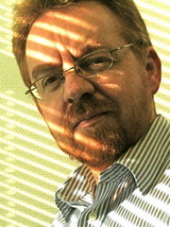Stephen Curry, a professor of structural biology at Imperial College London, likes to peer at the ‘inner organs’ of proteins and RNA. He blogs about this and other scientific matters at Reciprocal Space
Science is important because it’s got the X-factor. It is simply the best and most exciting way to explore the mysteries of the world around us, to find out what reality is, well, really like.
Most people don’t get it and that’s odd because reality seems to be terribly in vogue, so much so that TV producers are clambering over one another to put it on the box. On any given day you can goggle at D-listers in the jungle, has-beens in Big Brother or wannabes on Pop Idol. But the reality served up on TV is no substitute for the real thing. If you are looking for the shock of the new or a thrilling encounter with the unknown, then make your way to the science lab and start to grapple with reality itself. I’m not kidding. You see those guys in the white coats? They’re having a ball! Yes, yes, science is a process of serious, level-headed enquiry. It is systematic, it is ruthless, and it is utterly inexorable. But passionately so. And because of that passion to discover, science is also a thrilling ride of exploration: it has the gut-wrenching power to transform our understanding of ourselves and the universe around us.
Very few of us can claim to have commanded the power to completely change reality. It takes the genius of a Galileo, a Darwin or an Einstein to produce those theories that, every so often, suddenly shatter the whole world and immediately re-build it anew. But even ordinary scientists like myself can partake in smaller tremors of discovery, and that’s almost as much fun.
Since the very beginning of my research career, I have always enjoyed the sheer privilege of spending time probing and poking the very stuff of the world. Frankly I can’t believe that they pay me to do this. In my particular field of structural biology, we get to see the invisible in spectacular detail. We study the molecules - mostly proteins, nucleic acids or carbohydrates - that work together to sustain the amazing phenomenon that is life. Our techniques make for a very peculiar journey of discovery, one that can last many months, if not years. The molecules are too small to see, even with powerful microscopes, so we have tease them out gently with genetics, purify them for crystallisation and then zap the tiny glinting crystals that we grow with an intense, needle-thin beam of X-rays. All being well - the moment of truth is a tense one - the crystals will split the beam, sending it shooting off in many different directions. And bizarrely - dare I say it, mathemagically - the way they do this allows us to figure out what the molecules in the crystal look like, to see exactly how they are constructed from their constituent atoms. The invisible suddenly shimmers into view.
The long road into the unknown is beset with difficulty. For much of the time it’s just a hard slog. Like any voyage of exploration there are days of repetitive tedium and frequent setbacks: science can be unbelievably frustrating. But those instants of discovery, when a small piece of the unknown flips over in front of your eyes and is suddenly known, are moments of palpitating, breathless joy. For me the thrill of being the first to gaze upon a part of reality has been hidden from us since the beginning of time has got all the X-factor I’m looking for.
Sorry, Mr Cowell.
 Published by
Published by